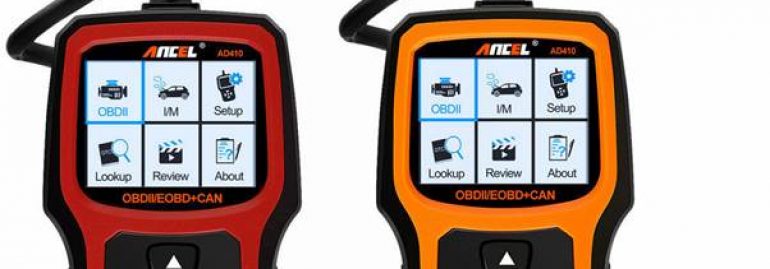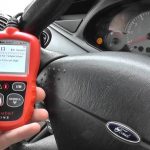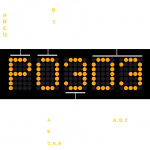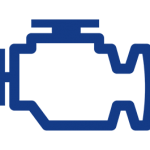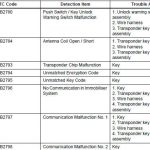You have probably heard about the on-board diagnostics system (OBD II) before. These systems give vehicles self-diagnosis and reporting capabilities. They are an excellent way to keep track of the state of a vehicle, enabling both the owner and the mechanic to quickly determine what’s wrong. This article will explore some of the most common dtc codes, their meaning, and the sources of these trouble codes.
Diagnostic trouble codes
The diagnostic trouble codes for OBD II are used to identify the malfunction of a car or truck. The codes are usually characterized by a letter prefix and four digits. These codes can be retrieved with a scan tool. The first digit specifies the type of code. It also indicates the system or part of the vehicle that has the malfunction. The last two digits designate the specific fault.
The most common trouble codes are P1xxx, P0xxx, and P0xxx. The first two codes are manufacturer-specific and cover areas outside of emissions. The third character identifies the system where the fault occurred. For example, the numbers 1 and 2 indicate a problem with the fuel or air metering system. Other trouble codes relate to the crankshaft position sensor, transmission, and airbags.
These codes are very important because they allow mechanics to determine the underlying cause of engine malfunctions. The codes can also help them identify repairs needed for a vehicle’s malfunction. For example, if the check engine light comes on, the problem could be related to the fuel level sensor or the emissions idle control system. Depending on the severity of the problem, the codes can indicate a simple gas cap issue or a complex malfunction of the engine.
To diagnose the problem, the PCM recognizes the problem and stores the DTC in the vehicle’s memory. The DTC’s purpose is to pinpoint the cause of a failure. Diagnostic codes for OBD II systems are required by law. Most vehicle manufacturers use a standard code list. The misfire code P0300 is a common example of this failure, but it is not the only failure in an OBD II vehicle.
Meaning of dtc codes
You can understand and identify a vehicle’s DTC codes by familiarizing yourself with the language used by the car’s computer. DTC stands for Diagnostic Trouble Codes. These codes are generated by the vehicle’s onboard diagnostics system to alert the driver to a specific issue. Most car codes start with a letter and will be followed by a number to identify the problem. In the case of obd II DTC codes, the first letter is the name of the fault and the second letter is the code itself.
OBDII codes are generated for vehicles that comply with the OBD2 standard. These vehicles generally are manufactured after 1996. They use the codes to self-diagnose vehicle problems. A vehicle’s engine can display a specific code if it is experiencing a specific issue, such as a malfunctioning oxygen sensor. A faulty sensor can cause a number of problems, including decreased fuel efficiency and engine stalling.
You should learn to identify your car’s OBD code in order to repair it. OBD codes are divided into Active and Pending Codes. The Active Codes are the ones that cause the Check Engine Light to stay on, while the Pending Codes are those that have been recorded at least once and will become an Active Code if they occur again. Often, these codes contain the specific information that a vehicle’s mechanic needs to repair or replace.
A vehicle with the P0300 DTC code could have a number of problems. A malfunction in the fuel system, for example, may cause multiple cylinder fires to occur. In addition to engine and transmission problems, this code is often triggered in conjunction with the P0301-P0308 codes. A J1939 code, on the other hand, has four characters, each representing a specific system.
Symptoms of dtc codes
OBD II is a diagnostic system used on most cars and has been standard for new models since 1996. It is a powerful tool for auto technicians because it allows them to see more information about your vehicle’s engine control system. Here are the most common symptoms and causes of OBD II dtc codes. Here are some tips to help you diagnose your car’s problem:
Critical DTC fault codes are ones that indicate an imminent engine failure. Using real-time vehicle diagnostics, you can identify the problem and find the nearest service center. But if the issue is not critical, you must still take it to a mechanic immediately. Non-critical DTC fault codes are those that do not cause excess pollution but still require professional attention. These include faults relating to the check engine light or the Malfunction Indicator Lamp. Lastly, type two DTC fault codes are used to record freeze frame failures.
Diagnostic trouble codes are stored in the Powertrain Control Module (PCM). A specific malfunction in a car results in a DTC. These codes help repair professionals pinpoint the problem. They are five-digit codes containing a series of symbols. Each digit describes a problem with a specific car part. The codes are also referred to as fault codes, and the Society of Automotive Engineers has an extensive fault manual available.
The symptoms of OBD-II DTC codes are different from each other. The P0128 indicates that the coolant temperature in the engine is below the temperature set by the thermostat. The P0128 code is a generic code that can be interpreted by the SAE definitions. In many cases, this code means that a problem is occurring in the fuel and air metering system.
Sources of dtc codes
OBD-II diagnostic trouble codes (DTCs) provide vehicle owners with important information on potential problems. More like a troubleshooting manual, these codes provide answers to frequently asked questions about your car. OBD-II-compliant vehicles include most cars produced after 1996 and most light trucks and diesel engines. Most heavy equipment also uses this technology. These codes are useful for troubleshooting problems and ensuring the safety of your car and those in the vicinity.
In 1996, vehicle manufacturers introduced DTC codes for cars and light trucks. As a result of the Clean Air Act and new EPA regulations, every automobile comes with an onboard diagnostic system. This system monitors every component and system in a vehicle. OBD-I codes are the oldest and are found on most vehicles manufactured before the 1990s. In comparison, OBD-II codes are used in cars and light trucks and have more sophisticated diagnostic abilities.
In OBD-II vehicles, the first codes usually indicate the problem. When dealing with an automobile, the first codes should be focused on, as these will indicate the underlying cause. Additional codes will be symptoms of the original problem and will disappear once it is repaired. Consequently, identifying the source of OBD-II codes is an important part of car repair. When determining the cause of a car’s check engine light, the DTC codes can help you make a better decision.
In the world of automotive diagnostic codes, there are a couple of different sources. First, the system of your car can generate hundreds of DTCs. Its function is to identify malfunctions in the various systems of the car. For example, the P0442 code means the emission system is leaking. In addition to the P0442 DTC, the P0782 code is generated by the car’s on-board computer.
Tools for reading dtc codes
The best tools for reading OBD II dtc code data are the ones that offer all the functions you need. You can buy a cheap diagnostic reader to test your ABS light, but this will not be of any help if your ABS light is on. However, there are some premium scan tools that offer advanced functions, including engine and ABS diagnostics. In addition to their price, these diagnostic tools are designed to provide detailed information on your car’s condition.
Basic code readers give you a five-character code that can be found on a vehicle’s computer. You’ll need to check the manufacturer’s website for a complete list of OBD II fault codes or consult the standard DTC list before purchasing a code reader. On the other hand, more comprehensive fleet management solutions offer complete code definitions and fault alerts for all types of vehicles. Basic code readers plug into a 16-pin OBD-II diagnostic connector, which is typically located on the left side of the steering column. However, some pre-1996 vehicles require special adapters for them to function properly.
OBD II DTC codes can be confusing to understand and interpret. It’s important to know the meaning of the codes before you try to fix the problem. In most cases, codes are simply an indication of a problem. However, it’s not always easy to figure out which parts and systems need to be replaced or repaired. This information is necessary for diagnosis and repair. To be able to interpret OBD-II codes properly, you’ll need to have some training.
OBD-II is a standard diagnostic connector that’s widely used in modern vehicles. The OBD-II standard specifies the type of diagnostic connector, electrical signalling protocols, messaging format, and candidate lists of vehicle parameters. The OBD-II connector is powered by the vehicle’s battery. Some technicians choose to use a separate auxiliary power source. To perform an accurate diagnostic, you’ll need a scanner that can connect to the OBD-II connector.


